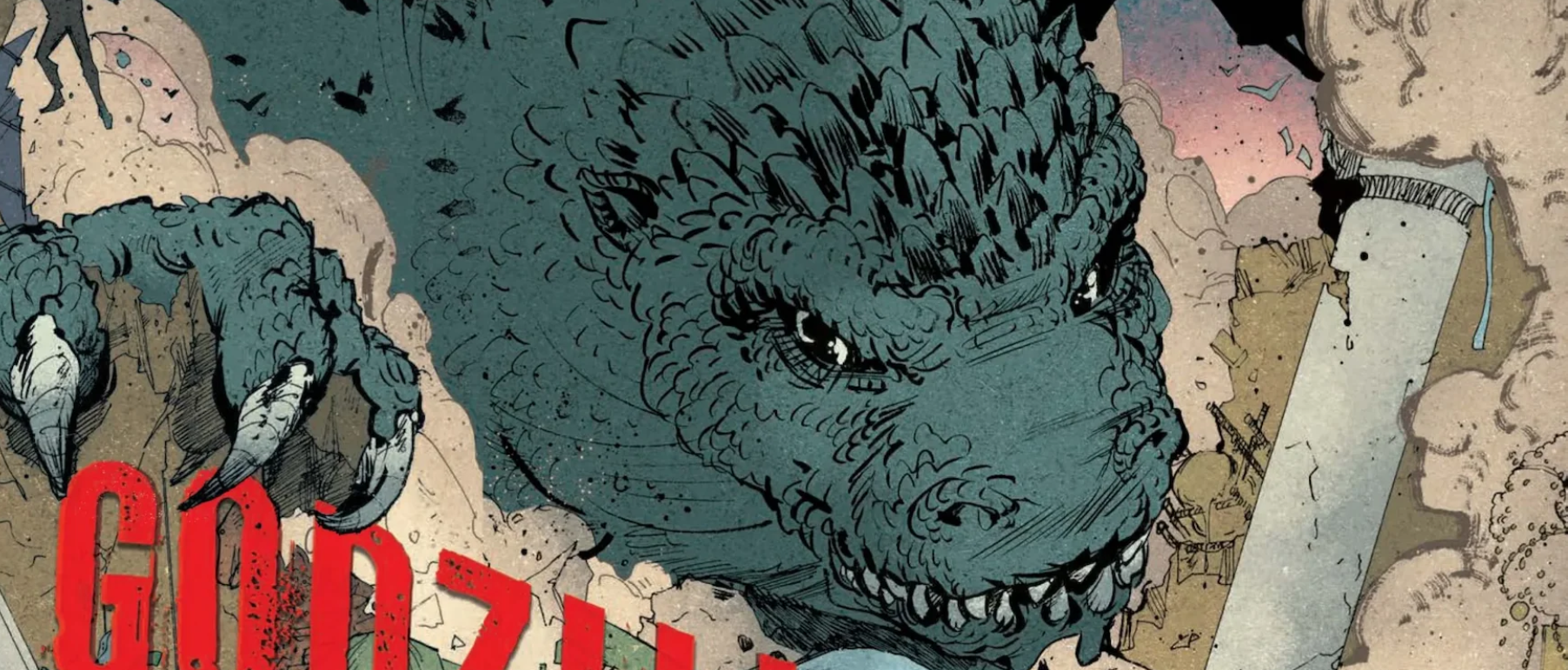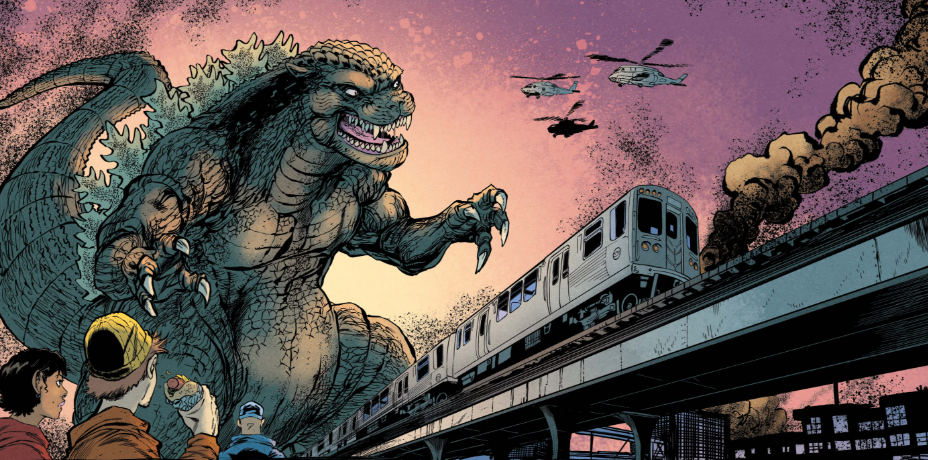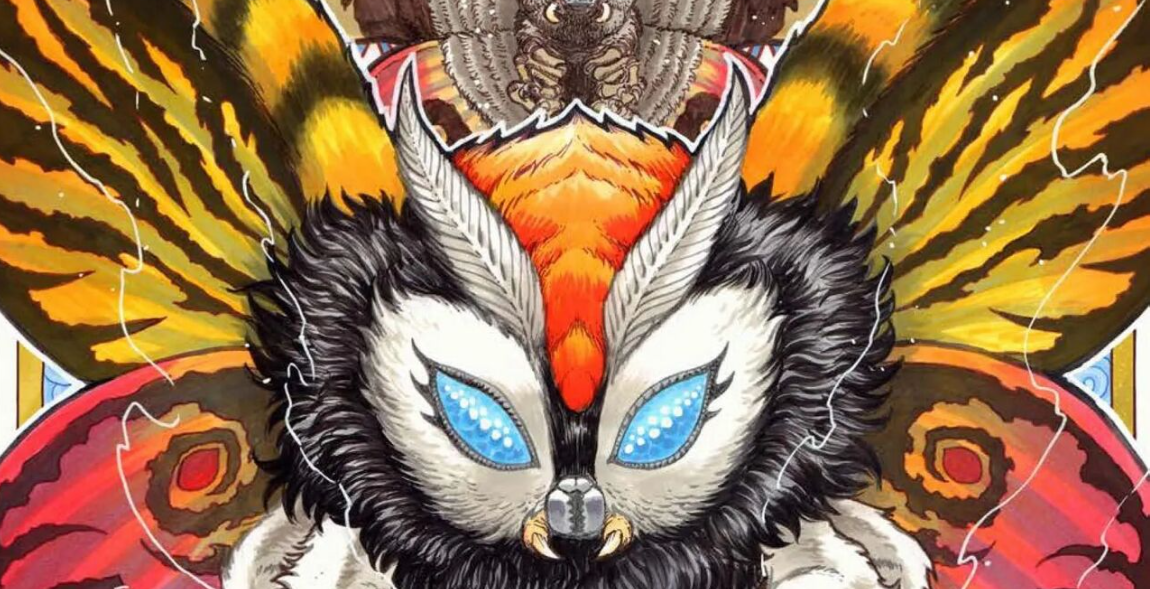
2024 is a year chock full of anniversaries. Godzilla (2014), and thus the MonsterVerse, has been with us for a decade as of a few days ago. Godzilla Final Wars is almost old enough to drink. The greatest movie of all time, Godzilla vs. Mechagodzilla is now half a century old. But most importantly, the one that started it all, Godzilla (1954) is turning 70 years old come November. And while Toho Studios released Godzilla Minus One to celebrate last year to critical acclaim, here in the U.S., the party is still going strong, and likely will continue to be all the way through the year.
Nowhere is this more evident than with IDW Publishing’s newly released one-shot, Godzilla: 70th Anniversary. An extra-long anthology book, 70th Anniversary brings together a plethora of different creative teams for a whopping nine different stories all celebrating the King of the Monsters’ long history. If nine stories packed into one comic book sounds like a lot, then imagine how tough it’ll be to review them all in one go!
However, before getting into the actual review, major props to artist Sophie Campbell, whose cover for this might be one of the most terrifying depictions of Godzilla yet! The way the light is only illuminating its lower torso, leaving its head, aside from its beady, soulless eyes and gnarly-looking fangs all but shrouded in darkness is sure to send chills down the spine of any who gaze upon it.
The first short story, The Half-Century Bore by James Stokoe, is, as its title implies, a companion piece to Stokoe’s excellent The Half-Century War miniseries, largely considered by many fans to be the quintessential Godzilla comic book. The story actually takes one of the concepts touched upon briefly in that series and expands on it a bit, that of the OTHER specialized teams employed by the Anti-Megalosaurus Force. This particular story focuses on Mehmet Yilmaz and Ömer Bulut as they deal with studying and containing the Smog Monster himself, Hedorah.
Also, as the title implies, the job isn’t all that thrilling, especially when compared to that of The Half-Century War’s Ota Murakami and Ken Yoshihara as they focus on Godzilla. One might even go as far to say the story plays out in an almost comedic way, hammered home even more by how everything comes to a close at the end of the story.
Stokoe’s artwork here is, unsurprisingly, fantastic. His attention to detail is second to none in the industry, and it’s part of the reason comics fans pay attention to pretty much anything he’s attached to. Stokoe is a master at creating a very lived-in looking world, and despite only being a few pages long, he puts his all into those pages, especially taking into consideration the few time skips sprinkled throughout. Overall, a very good start to the anthology, and a fitting one given the original series’ reputation among fans.
Next up, Contagion, by Dan DiDio, with art by Joëlle Jones, colors by Marko Lesko and letters by Rus Wooton. When the anthology was first announced, many fans seemed excited at the prospect of DiDio’s contribution, and it seems their faith was not unfounded, because Contagion is quite good. This story focuses on virologist Mizuno, who has developed a mysterious virus. It’s never quite clear for what reason the virus was developed (Mizuno stresses that it “was never meant to be weaponized”), but it ends up being all for naught anyways, as the virus unleashes a kaiju! A brand-new kaiju making its debut here, a giant mosquito by the name of Usuru, who is able to spread plague wherever it goes, causing a minor pandemic in Japan. Considering the Godzilla franchise has played hosts to giant moths, spiders, mantises, and dragonflies, it’s a wonder it took 70 years for a mosquito to come into play.
Naturally, Godzilla eventually comes ashore to confront this threat, and the big guy looks really good here! It reminds one of Phil Hester’s take on the character in the early issues of IDW’s first Godzilla comic, Kingdom of Monsters, mostly in the face. Spoiler alert, but Godzilla takes down Usuru before turning its wrath on those who unleashed such a horror to begin with. It’s a classic tale of nature keeping mankind in check, and while a late-game twist kind of feels like a cop-out, the effects of that twist still make the story feel poignant by the end.
Unfortunately, this is where the book starts to falter a bit in its consistency. Of Gods and Con Artists, by Danny Lore, with art by Sebastián Píriz, feels a bit like missed potential. The story follows Ito, the titular con artist as he attempts to sell fake Destoroyah remains to a local crime family for a quick buck. An expert, Dr. Kikuchi, almost finds our not-quite-hero out, but Ito is saved at the last minute as the city is caught up in a titanic battle between Godzilla and Biollante. Hara, the crime family’s muscle, survives and attempts to kill Ito for his lies, but things don’t go so well for him either, with Ito realizing that in the grand scheme of things, all his lies over the years are infinitesimal compared to the size of these monsters.
Perhaps it’s the mob story trope, but it’s hard not to compare this story to another of IDW’s early titles, Gangsters & Goliaths, a book that dealt with much the same themes as the ones here, and, as it has a whole five issues to tell its story, did so in a much more satisfying way. Not to mention, Ito’s initial motivation here is much more selfish than Makoto Sato’s in that book. Perhaps without prior knowledge of Gangsters & Goliaths, this story would resonate better.
Next up, one that feels like it celebrates specifically the release of the original film, In the Shadow of a God, by Matt Frank, featuring poetry by Kaiju United’s own Donny Winter, and Japanese calligraphy by Maki Takarada. With Frank’s reputation in the fandom as one of the most popular artists in the game, this seemed to be the story that many fans were anticipating the most. And boy, if he doesn’t deliver right from the get-go. The story follows an unnamed school-girl caught up in Godzilla’s attack in 1954. Seemingly the only sign of life in Tokyo, our heroine comes upon another, unlikely survivor: a trilobite, left in the wake of Godzilla’s destruction, much like the one found on Odo Island in the original film. Rescuing the prehistoric creature, they struggle to survive throughout the monster’s rampage, before finally releasing her new friend back into the ocean along with Godzilla.
Anyone familiar with Frank’s work should expect nothing but the best from him, and at the risk of sounding vague (so as not to spoil anything), the first page-turn into this short story rewards the reader with one of the most impressive splash pages in Godzilla comic history. The most comparable imagery might be the immediate aftermath of the atomic breath in Minus One. It’s a most fitting title page, as it really does feel like you’re in the shadow of a god, and something about Takarada’s Japanese calligraphy being used for the onomatopoeia, rather than the usual English, lends Godzilla all the more terrifying presence. Despite the apocalyptic imagery conjured up by Frank (done mostly in grayscale to better sell the aesthetic), Winter’s achingly beautiful poetry, told from the perspective of the child protagonist, reminds the reader that not all hope is gone. Even in the face of the king kaiju’s atomic breath, the protagonist comes to empathize with the creature, finding surprising comparisons with that of her new companion.
E.J. Su is an artist that, while he hasn’t done a whole lot in the realm of Godzilla, should get more recognition. His art in the Hedorah issue of Godzilla: Legends was especially eye-catching, creating a haunting world of pollution (which makes sense, given the subject matter), and his artwork in the Hedorah issue of Godzilla: Rivals, despite being a totally different style, was equally as fitting for the 1970s setting. In the Darkness, in which Su takes full creative control, opts for another totally different yet fitting artstyle; watercolor. The story is told from the perspective of a young child, who suffers from nightmares about Godzilla.
As such, the art-style creates a feeling of childlike wonder… Until Godzilla enters the picture. Thankfully, for the young boy, Godzilla’s not the only kaiju to show up in his dreams: Jet Jaguar appears to help the boy conquer his fears by giving the big lizard a run for its money. An interesting detail in this dream sequence appears that both Godzilla and Jet Jaguar both are NOT rendered in the watercolor styling of the real world but rather in a sharper focus, further adding to the dreamlike quality of the tale. Despite being on a smaller scale than some of the other stories, In the Darkness is by no means lesser for it. It’s a story that likely speaks to a lot of fans’ experiences in their youth. Perhaps not exactly the “fear of Godzilla” part, though.
The Big One, by Adam Gorham with colors by Adam Guzowski is a story about overcoming great odds. As familiar a tale as one can get, even in the realm of the King of the Monsters. In this story, Pop, Hector and Lisa are attempting to get out of town in the midst of a titanic battle between Godzilla and another new kaiju, which sadly goes unnamed in the book: a giant, glowing vampiric snail. Naturally, this is all taking place during a flood as well (or perhaps the snail is the cause of the flood), so there’s even more incentive for them to leave. Pop is reluctant to leave behind his store that he ran with his departed wife Junie, but when there’s two giant monsters in town, there’s not much choice. They run into two other survivors, Ray and Bo, and move to higher ground in hopes of staving off the water and the additional man-sized, as well as man-eating snails. Eventually they’re rescued, and months later, it’s revealed that Pop is planning on opening his store back up, despite all the destruction.
Despite the rather striking artwork (the big snail is the star here), the story overall feels played out, or perhaps not fleshed out enough. There’s a lot to play around with with a trope like this, and unfortunately it feels a bit like a missed opportunity. There’s plenty of action as the survivors fend off the smaller snails, but there’s not enough substance interspersed here to bring it all together by the end, and the reader is unfortunately left wanting more.
Godzilla and the Western genre have never really crossed over before, and that’s a shame. Thankfully, Casey Gilly fulfills this wish with Ain’t No Place for an Angel, bringing along Liana Kangas for the artwork and Brittany Peer for the colors. Set in Senica Springs, an old mining town populated by women who have been cast out by society, watched over by the mysterious queen and her “two daisies.” An unnamed outlaw enters the town, demanding the gold stashed away in the mine (despite the mine having gone bone dry years ago), but Mothra, the aforementioned queen appears to defend the town. Unfortunately, Mothra’s presence in Senica has attracted Baragon, whose appearance causes enough of a distraction that the outlaw heads down into the mine, the mine collapses in fight, killing him. Mothra is injured in the fight, but Zadie, a blacksmith (with a little help from Godzilla), is able to forge a prosthesis for her out of gold, allowing the queen to take flight once more.
Pacing is this story’s biggest issue. It feels like things just keep happening one after other, with no breathing room to allow the reader to take stock of events. If this story had been a bit longer, or even been its own one-shot (make it a Mothra vs. Baragon issue of Rivals!), it would’ve been much more effective, but as it stands, everything happens at such a breakneck pace that it’s hard to keep track of what’s going on. An unfortunate circumstance of this is that Godzilla ends up being no more than an afterthought, showing up in a whopping three panels throughout the whole story, and in an anthology book that’s celebrating the 70th anniversary OF Godzilla, it feels out of place with the some of the rest of the entries here. And while Kangas’ artwork is eye-catching at times, a sense of scale is pretty much nonexistent. Sometimes Mothra appears to be about the same size as a full-grown human, but when she’s doing battle with Baragon, she’s more the size one would come to expect from the Queen of the Monsters.
It’s interesting that In Summation, by Michael W. Conrad, with art by Gegê Schall should appear in a book that includes a companion piece to The Half-Century War, as it runs with a very similar concept. Tomoyuki Abrams is born on the day that Godzilla first makes landfall in Japan in 1954 and his father is among the souls lost during the creature’s rampage. Abrams commits his life to studying the creature, hoping to one day find a way to kill it, even after its more heroic turn after defeating Mechagodzilla. As he details his life story, Abrams eventually comes to realize that, despite what it took from him, he does have a deep-seated respect for the monster. He eventually even stops trying to understand the creature. “Even claiming it to be an uncaring god, or a force of nature, loses something,” he says in his notes. “…Try as we may to decode such things, they simply are.” Godzilla isn’t an animal, or a monster, or a god. Godzilla is Godzilla.
It’s really such a fun concept that it’s almost shocking that it hasn’t been implemented in any of the films. Abrams’ dialogue, presented as recovered notes from his journal after his death at the hands of the very thing he devoted his life to, goes through a whirlwind of emotions; anger at Godzilla for the death of his father, cautious wonder at its status as the King of the Monsters, before finally the acceptance that its existence is bigger than anything a human could comprehend. The artwork here is a bit hit or miss. While some shots of Godzilla are very clearly traced from screenshots or publicity photos, the back half of the story, where Abrams is tracking Godzilla at sea, are pure spectacle, reminiscent of the opening battle in Pacific Rim. The final page is especially striking; while Godzilla is rendered here in a mishmash of late Showa era designs, the destruction of the boat at its hands hammers home that it’s not exactly the friendly version of the character from those films.
The final story of the anthology, Aftermath, by Natasha Alterici, takes a familiar concept to the franchise and comes really close to doing something interesting with it. As the title suggests, the story picks up during the immediate aftermath of Godzilla’s landfall, following a number of unnamed survivors as they attempt to pick up the pieces of their lives; a news report states that “an estimated 400,000 people have been displaced,” with no sign of a rescue any time soon. All the while, the story cuts to an unnamed billionaire, who, unsurprisingly, has no sympathy for those affected. This is made all the worse by the heavy implication that his company was responsible for either creating or luring Godzilla up from the depths in the first place by dumping radioactive waste. Thankfully, he gets his comeuppance, as the survivors eventually rally and storm the gates of his mansion.
If that sounds somewhat vague, that’s because it is. The survivors only ever allude to “making things right,” but it’s not clear as to what exactly that means. Sure, it might sound like storming the mansion would eventually lead to the cessation of the dumping, but a conversation between the survivors shortly before this happens makes it sound like they’re instead on their way to confront Godzilla head-on, with one even calling it a “suicide mission.” This is by far the story’s biggest failing, because up until that point, it’s really very good. The opening is especially heartbreaking, watching the survivors take stock and realize just how much they’ve lost in the attack; one need only compare it to Shikishima’s loss of Noriko after Godzilla unleashes its atomic breath in Minus One to understand how these characters are feeling.
All in all, Godzilla: 70th Anniversary mostly succeeds in acting as a big celebration of the last 70th years for the franchise (some more so than others), and if anything, serves as a showcase of what other creatives can do with the property. Godzilla can mean so many different things to so many different people, and nowhere is this more evident than in this book. So, while it might be a bit of a mixed bag, at the end of the day, it’s still a pretty good mixed bag. Like one of those variety candy packs around Halloween. There’s a few types of candy in there that are really good, fan favorites, but also some candy that, while still delicious, isn’t quite most people’s favorite. Most will undoubtedly go for the Reese’s cup over the pack of Whoppers.




